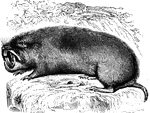
Gopher
"It is of a pale yellowish-gray, seven and a half inches long, and derives its common name from its…
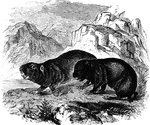
Sewellel
"It is about the same size of the gray rabbit, being fourteen inches long with a tail half an inch long.…

Rock Rat
Petromys Typicus. "These animals move upon the hind-legs, which are not much larger than the fore-ones;…

Hilton Head
"Exterior view of fortifications erected by the Federal troops at Hilton Head, Port Royal. S. C. Hilton…
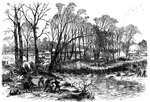
Battle of Stone River
"Battle of Stone River, Tenn. The decisive charge of General Negley's division across the river- the…

Battle of Gettysburg
"Battle of Gettysburg, Cemetery Hill during the attack of the Confederates, Thursday evening, July 2nd,…

Garibaldi Guards
"Camp of the Garibaldi Guards, Colonel D'utassy, near Roche's Mills, Va., Potomac River in the distance.…
Fort Taylor
"Fort Taylor, Key West, Fla. Key West, the most western of the Pine Islands, is about sixty miles southwest…

Battle of Chancellorsville
"Battle of Chancellorsville, Va. Attack on General Sedgwick's Corps. on Monday, May 4th, 1863, at 5…
Falmouth
"The town of Falmouth, Va. on the Rappahannock, opposite Fredericksburg. Headquarters of General Burnside…

Battle of Chickamauga
"Battle of Chickamauga- repulse of the Confederates at Crawfish Creek. We present a most interesting…

Cutting Levees
"Cutting the levees near the state line of Louisiana and Arkansas, twenty miles above Lake Providence,…

Battle of Coal Harbor
"Grant's Campaign in Virginia. The Battle of Coal Harbor, June 1st, 1864. On the 1st of June the Confederates…
Burnside's Corps
"The war in Virginia. Burnside's corps charging the Confederate position on the right of the enemy's…

Battle of Spottsylvania
"The war in Virginia. Battle of Spottsylvania Courthouse- opening of the fight at Alsop's Farm, May…

Eighteenth Corps
"The war in Virginia. A regiment of the Eighteenth Corps carrying a portion of Beauregard's line in…

Belle Isle
"View of Richmond, Va., from the prison camp at Belle Isle, James River. Belle Island is situated in…

Battle of Bentonville
"The Battle of Bentonville, N. C.- Major General Mower, commanding First Division, Seventeenth Corps,…
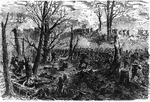
War in Tennessee
"The war in Tennessee. Capture of Mission Ridge, near Rossville, by General Thomas, November 25th, 1863.…
!["Siege of Petersburg- the Ninth Corps charging on the enemy's works after the explosion of the mine, July 30th, 1864. Immediately after the explosion of the mine a hundred cannons opened along the Federal front, and at half-past five the Ninth Corps charged, carrying the fort with a part of the line on each side. The Second Division, which was in the centre, advanced and carried the second line a short distance beyond the fort, and rested, holding ground with the utmost determination. It was at the time the [African American] Division, under General White, was pushed forward and ordered to charge and carry the crest of the hill, which would have decided the contest. The troops advanced in good order as far as the first line, where they received a galling fire, which checked them, and although quite a number kept on advancing, the greater number seemed to become utterly demoralized, part taking refuge in the fort, and the remainder running to the rear as fast as possible. They were rallied and again pushed forward, but without success, the greater part of the officers being killed or wounded."— Frank Leslie, 1896](https://etc.usf.edu/clipart/11800/11856/petersburg_11856_mth.gif)
Siege of Petersburg
"Siege of Petersburg- the Ninth Corps charging on the enemy's works after the explosion of the mine,…

Lapland Lemming
"Of the Lemming genus, the Lapland Lemming is the most celebrated which is confined to Lapland and Norway.…

Sminthus Loriger
"Two and a half inches long, with a tail of nearly equal length. It is of a grayish-brown, with a black…
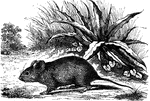
Caffrarian Otomys
"Is of a grayish-fawn, six inches long, with a tail two and a half inches. it is found at the Cape of…

Harvest Mouse
"The smallest of mice, and perhaps the very minutest of mammalia, an English half-penny weighing down…
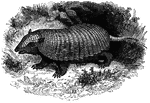
Giant Tatou
"In this carapace covers the body above and low down on the sides, but leaves the belly unprotected;…

Second Battle of Bull Run
"Second battle of Bull Run, fought Saturday, August 30th, 1862, between the Federal forces commanded…

Fort Fisher
"First assault upon Fort Fisher, Sunday, January 15th, 1865. The One Hundred and Seventeenth New York…
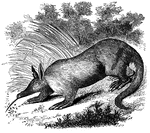
Aardvark
"It is about three and a half feet long, the tail one foot nine inches. It has a long callous snout…
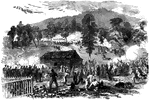
Battle of Rich Mountain
"The battle of Rich Mountain, Beverly Pike, Va., between a division of Major General McClellan's command,…
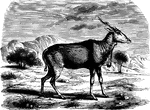
Eland
"Is considerably the largest of all the antilopes, being the size of a good horse, and measuring eight…
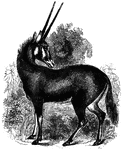
Gemsbok
"It is a heavy stout animal, about five feet in length, and three feet two inches high at the shoulder;…
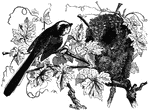
Long-Tailed Titmouse
The most noted of the titmice, the long-tailed titmouse is about five and a half inches in length, half…
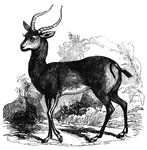
Pallah
"Four and a half feet long and three high. The general color is a deep red, and underr parts being white.…
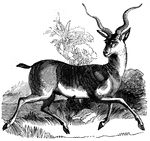
Common Antelope
"Its length is four feet; its height two and a half; the legs are long and delicate; the body round,…
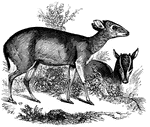
Kleene-Boc
"Is about one foot high at the shoulders; the horns one and a half inch long in the male, three quarters…
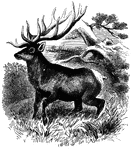
American Elk
"is a large and noble species, resembling the red deer of europe; is has tall, round, branching horns,…
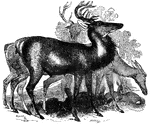
Male American Deer
"It is about the size of the European fallow-deer, and resmebles it in temper and character; the color…
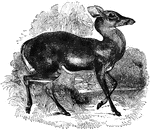
Female American Deer
"It is about the size of the European fallow-deer, and resmebles it in temper and character; the color…

Black-billed cuckoo
Averaging about twelve and a half inches in length, the black-billed cuckoo resembles the yellow-billed…
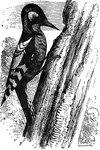
Great Spotted Woodpecker
The great spotted woodpecker measures an average of nine and a half inches long, and is found throughout…

Battle of Williamsburg
"Battle of Williamsburg, Va., on the peninsula between York and James Rivers, May 6th, 1862. General…
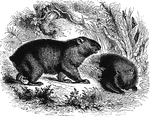
Wombat
"A short-legged, thickset animal, the body two feet long, the tail half an inch long. It lives in burrows…

Isle Aux Noix
Isle Aux Noix, in the Sorel. The sketch was made from the pilot's room of the steam-boat, about half…
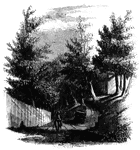
Wolfe's Ravine
Wolfe's Ravine. This scene is about half way up the ravine from Wolfe's Cove, looking down the road,…
!["The broad-billed sandpiper.. [is] six and a half inches long, variegated above with black, rufous, and gray; beneath grayish-white, tinged with buffish-red; rare, but distributed throughout Europe." — Goodrich, 1859](https://etc.usf.edu/clipart/13000/13073/bblldsndpipr_13073_mth.gif)
Broad-Billed Sandpiper
"The broad-billed sandpiper.. [is] six and a half inches long, variegated above with black, rufous,…
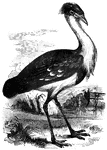
Black-Billed Bustard
Found in India, the black-billed bustard can measure up to four and a half feet in length.
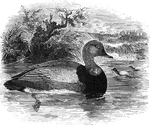
Pochard
The pochard (or dun-hen) averages about nineteen and a half inches in length, and is found in parts…
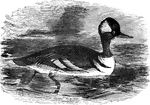
Hooded Merganser
Measuring about nineteen inches long, the hooded merganser is common in North America, its head adorned…
Niagra Bridge
Part of Niagra Suspension Bridge. This view, looking up from the river, comprises about one half the…

Caughnawaga Church
Caughnawaga church. This old church, now (1848) known as the Fonda Academy, under the management…

Old Parsonage and Church
Old Parsonage and Church. This view is from the high plain on the right of the block-house, looking…
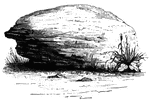
Brant's Rock
Brant's Rock. This rock, which is about four feet high, lies in a field on the left of the road leading…
![The Yeoman House. This view is from the road, looking north. An attempt was made by a soldier to burn the house, but so rapid was the march of the invaders that the flames had made but little progress before the troops were far on their road to the village. An [African American] woman, who was concealed under some corn-stalks near, extinguished the flames. The house is about half a mile from the river, on the right side of the road from the landing to Kingston village.](https://etc.usf.edu/clipart/13500/13510/yeoman_13510_mth.gif)
Yeoman House
The Yeoman House. This view is from the road, looking north. An attempt was made by a soldier to burn…

Milford Hill
West Bridge and Milford Hill. This view is from the Milford Road, eastward of West Bridge. The high…

Campbell's Monument
Campbell's Monument. This rude memorial was erected in 1831, by J. W. Barber, Esq., of New Haven, the…

Buckley House
The Buckley House. This building stood upon the eastern side of the Green, fronting the church. It was…
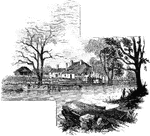
Greene and Knox Head-Quarters
"Head-quarters of Greene and Knox. This view is from the turnpike road, looking southeast. The water…


